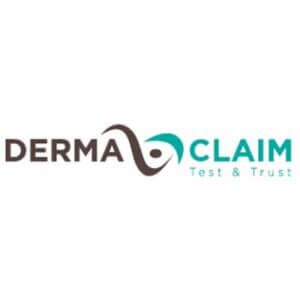3D High-Resolution and Automatic Skin Topography for Anti-ageing Claim Substantiaition by Dermaclaim
6 February 2023
One of the major challenges of the 21st century is the fight against aging, defined as a set of both physiological mechanisms altering the physical and intellectual capacities of human beings. Aging of the skin is only one visible part of this process and one of the most prevalent cosmetic concerns to women [1]. The many noticeable manifestations such as wrinkles, sagging, uneven skin tone, and dull and dry skin can significantly impact self‐esteem and social relations [2]. Indeed, the obsession with a youthful appearance has become commonplace in modern society and has resulted in an upswing in cosmetic treatments trying to reverse the aging process [3].
Dermaclaim is a dermocosmetic testing laboratory located in Valencia (Spain), focused in the analysis of products and the validation of efficacy claims, through in vitro bioassays and clinical tests in human volunteers. Aging biomarkers such as wrinkles, roughness, facial pores, sagging, face volume and plumpness, eye bags, lips volume, etc.… are clinically assessed in Dermaclaim by 3D high-resolution and automatic skin topography through using AEVA-HE with VisioTOP-500 bench.
AEVA-HE is a high-resolution 3D equipment with automatic operation, based on a patented fringe projection unit combined with stereo imaging techniques (active stereometry), offering the best performance and flexibility for 3D skin topography analysis. It offers pixel resolution in X,Y and high accuracy in Z, thus, being less sensitive to movement. Combined with VisioTOP-500 bench, including motorized table for height adjusting, mirror and infrared laser for face positioning, and earplugs and head rest for head adjusting; it constitutes a simple system to position and reposition your volunteers at different timepoints, which provides greater reliability, robustness, reproducibility, and automation. Additionally, the software included in the AEVA-HE provides an automatic selection of the Region of Interest (ROI) after processing and alignment of the obtained data, so the selection of the area of analysis is not manually selected, as in other technologies in the market.
Wrinkles can be evaluated in any specific area of the whole face using 3D object detection with threshold value. Parameters such as total area, number, perimeter, volume, and depth, are automatically obtained for each volunteer in each region of interest, after applying a Z threshold (plane) to the topography obtained before and after the treatment. This is the most widely used biomarker to substantiate anti-aging and anti-wrinkles claims.

Wrinkles density can be also detected in the whole face using a larger field of view in a bigger area of detection, even though resolution is lower, compared to the previous analysis in specific region of interests.
Skin surface or profile roughness can also be assessed using AEVA-HE. All the points of the topography in the ROI are evaluated to calculate roughness parameters such as Stm, Sa, and St, among others. The distance between the peak and the valley of each profile of the measured surface is measured in millimeters. A reduction in these parameters is the perfect instrumental substantiation to defend smoothing effects (reduction of skin roughness).

This roughness analysis makes also sense when looking at skin patterns which are evenly spread over the topography, for example, to calculate the presence of facial pores. Moreover, in the same manner as previously explained for wrinkles, facial pores can also be detected using object detection through threshold value.

Face volumes are also quantified using AEVA-HE system. Volume evaluation calculates the global volume and surface of the topography, compared to a Z (threshold) plane. The reference plane is considered at Z=0, calculated on T0 shape, to increase the sensitivity of the quantification. Anything which is higher than the plane is considered as positive volume and area (plumpness effect), whereas anything which is lower than the threshold plane is negative volume and area (slimming or anti-sagging effects). 3D volume for plumpness effects is usually evaluated near the cheekbone, whereas face volume for slimming or anti-sagging effects are frequently assessed in the jawline or neck jowls.

Together with the analysis of volumes, the system allows to quantify the length of the face section, in order to obtain additional information to substantiate the claims skin plumpness or skin slimming / anti-sagging.

In conclusion, this automatic 3D high-resolution technology provides Dermaclaim the possibility to offer innovative tests to substantiate the clinical antiaging effects in a robust, reliable, and reproducible manner, obtaining instrumental data together with impressive images and 3D reconstructions for marketing purposes.
1.- Françoise Boismal, Kevin Serror, Gabor Dobos, Elina Zuelgaray, Armand Bensussan, Laurence Michel. Vieillissement cutané – Physiopathologie et thérapies innovantes. Med Sci (Paris) 36 (12) 1163-1172 (2020). DOI: 10.1051/medsci/2020232
2.- Rattanawiwatpong P, Wanitphakdeedecha R, Bumrungpert A, Maiprasert M. Anti-aging and brightening effects of a topical treatment containing vitamin C, vitamin E, and raspberry leaf cell culture extract: A split-face, randomized controlled trial. J Cosmet Dermatol. 2020;19(3):671-676. Doi:10.1111/jocd.13305
3.- Honigman R, Castle DJ. Aging and cosmetic enhancement. Clin Interv Aging. 2006;1(2):115-9. Doi: 10.2147/ciia.2006.1.2.115. PMID: 18044108; PMCID: PMC2695163.
Contact
David González
Chief Executive Officer
dermaclaim@dermaclaim.com








 Follow us on Linkedin!
Follow us on Linkedin!
You must be logged in to post a comment.